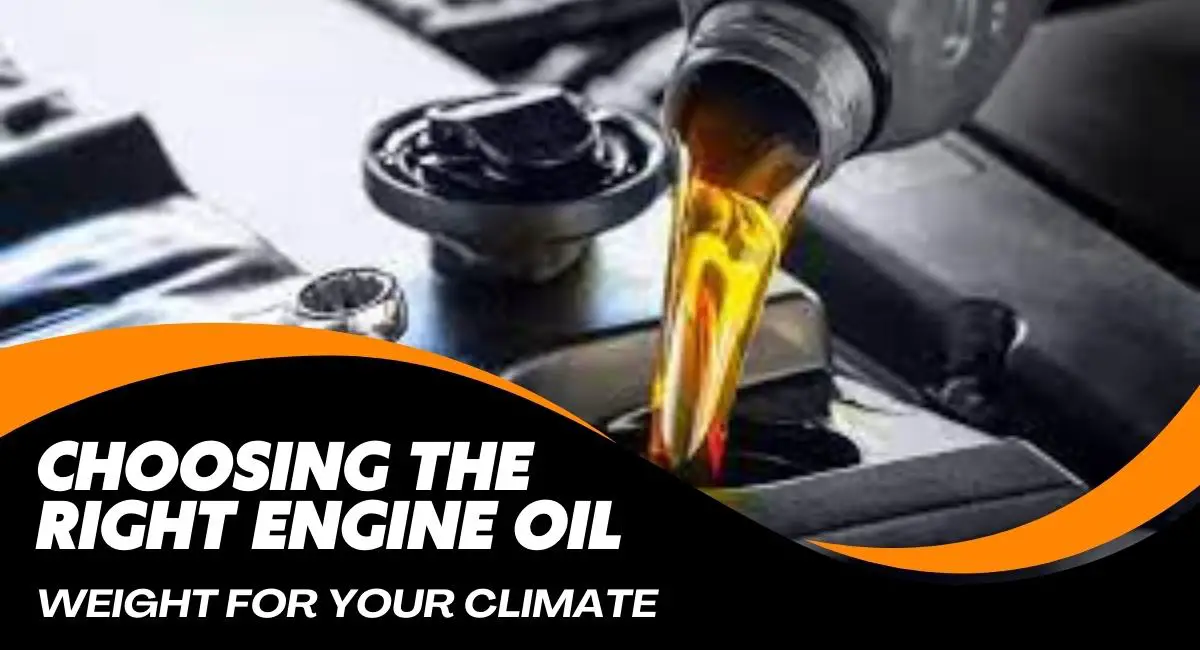Maintaining your vehicle is a crucial aspect of ownership, and one of the key components is selecting the proper engine oil. Engine oil is vital in ensuring your vehicle’s smooth operation and longevity. But what is the right engine oil weight for your climate?
Too thick engine oil hinders flow; too thin compromises protection. While viscosity shifts with temperature, it creates a tradeoff between performance and protection when selecting motor oil.
This article provides a comprehensive overview of the intricacies of choosing the proper engine oil weight for different climates. Let’s explore the following topics:
- Understanding engine oil viscosity
- Finding the appropriate engine oil viscosity for different climatic conditions
- Engine oil additives and their impacts on climate
- The nuances of synthetic versus conventional oils.
- Tips for changing engine oil in different climates:
What is Engine Oil Viscosity?
Before you settle for the right engine oil weight for your climate, it is crucial to understand engine oil viscosity. So, viscosity is the oil’s resistance to flow or thickness under different temperature conditions. It is an essential property of motor oil that directly impacts its performance in various climates and operating conditions.
The viscosity of engine oil is determined by its composition and formulation, and it plays a vital role in ensuring proper lubrication and protection of engine components. However, you must know engine oil categorization for appropriate selection.
SAE comes in to categorize engine oil viscosity. SAE is the Society of Automotive Engineers, established as a standardized system for classifying engine oil viscosity, denoted by a numerical code such as 5W-30 or 10W-40.
The viscosity grade consists of two numbers, and each number signifies different aspects:

1. Winter Viscosity (First Number with “W”)
The first number, followed by a “W,” represents winter viscosity. It indicates how well the oil flows at low temperatures. A lower number, such as 0W or 5W, means the oil is thinner and flows more easily in cold conditions, ensuring proper lubrication during cold starts.
Let’s take a closer look at a common oil designation, 5W-30. The ‘5W’ indicates the oil’s viscosity in winter, while ’30’ signifies its viscosity at operating temperatures. You might opt for a lower ‘W’ number for colder climates, while a higher second number is suitable for hotter climates.
Find below more about the second number.
2. Operating Temperature Viscosity (Second Number)
The second number in the viscosity grade represents the oil’s viscosity at average operating temperatures. A higher number, such as 30 or 40, indicates a thicker oil that maintains viscosity under high temperatures. It is crucial for providing sufficient lubrication and protection to engine components during regular driving conditions.
Extreme climates require special attention. If you’re dealing with freezing winters and scorching summers, a multi-viscosity oil, such as 0W-20 or 10W-40, can be a reliable choice. These oils provide the flexibility needed to perform well in various temperatures.
Now, this is a basic understanding of the numbers. Still, there’s more to selecting the engine oil, as discussed below:
What is the Right Engine Oil Selection in Different Climatic Conditions?
Climate exerts a significant influence on engine oil performance. In cold weather, the oil needs to remain fluid to ensure proper lubrication during start-up, while in hot weather, it should maintain stability to prevent excessive thinning.
Let’s explore how different climates impact engine oil and what considerations should guide your choice.
Cold Weather Considerations
In regions with frigid temperatures, choosing a lower-viscosity oil is critical. For instance, a 0W or 5W oil will flow more easily in cold weather, ensuring your engine is adequately lubricated during those chilly starts. Thicker oils in such conditions can result in sluggish starts and increased wear on engine components.
Hot Weather Considerations
Conversely, opting for a higher-viscosity oil, such as 10W or 15W, is advisable in hot climates. It ensures the oil maintains sufficient thickness under high temperatures, preventing it from becoming too thin and losing its lubricating properties. Thinner oils in hot weather may increase friction and heat, potentially causing engine damage.
Moderate Climates
For those living in temperate climates, a balanced approach is vital. A 5W-30 or 10W-30 oil strikes a good compromise, providing adequate protection in cold and warm conditions. It’s essential to consider the typical temperature range of your location to make an informed decision.
Extreme Climate Conditions
A multi-viscosity oil like 0W-20 or 10W-40 may be the best choice in regions with extreme temperature fluctuations. These oils adapt to temperature variations, offering adequate lubrication in cold and hot conditions.
Engine Oil Additives and Their Impact on Climate Performance
Engine oils are not just about viscosity; they also contain additives that enhance their performance in specific climates. Some additives you will likely encounter include antioxidants, dispersants, antiwear, and viscosity indexes.
Understanding these additives is essential for making an informed decision about the right engine oil for your vehicle and boosting fuel efficiency!
Overview of Common Additives
Engine oil additives serve various purposes, including cleaning, dispersing contaminants, reducing friction, and preventing wear.
Detergents
Clean and prevent the formation of deposits in the engine. This is particularly beneficial in humid climates with a higher risk of sludge and deposit formation.
Dispersants
Disperse and suspend contaminants additives prevent debris from accumulating in the engine. Effective in all climates, dispersants maintain engine cleanliness by avoiding the accumulation of particles, which is critical in dusty or polluted environments.
Anti-wear agents
Reduce friction between moving parts, minimizing wear and tear. Critical in extreme temperatures, they ensure proper lubrication in cold conditions and prevent excessive friction and heat in hot climates.
Viscosity Index Improvers
It stabilizes oil viscosity across various temperatures. These are particularly beneficial in areas with temperature variations; they help maintain consistent oil thickness, ensuring proper lubrication in cold and hot conditions.
How Additives Enhance Performance
In cold climates, additives such as pour-point depressants help maintain oil fluidity, preventing it from thickening excessively. In hot climates, anti-oxidants and anti-wear additives play a crucial role in protecting the engine under high-temperature conditions.
Choosing Oil with Appropriate Additives
Consider your vehicle’s specific needs and the prevalent climate conditions when selecting engine oil. For instance, if you live in an area with high humidity and temperatures, an oil with robust anti-oxidant properties can help combat oxidation and extend oil life.
Synthetic vs. Conventional Engine Oils in Different Climates
As you consider the appropriate engine oil in different climates, you must understand the two varieties–synthetic and conventional oils. So, have you ever heard of synthetic oils? Think of it as an answer to enhance the smoothness and coolness of your engine to enable improved fuel efficiency and an extended engine lifespan.
Besides, conventional oil is a petroleum-based lubricant derived from crude oil through refining processes. It is the traditional type of motor oil used in most vehicles and is generally less expensive than synthetic alternatives.
It is worth noting that synthetic oil, engineered for superior performance and protection, outperforms conventional oil. It offers enhanced temperature resistance, minimized carbon deposits, and improved wear protection for your engine.
Synthetic and conventional oils provide different benefits for the engine in different climates. Now, let me tell you the preferred oil in your climate.
Synthetic Oils in Extreme Temperatures
Synthetic oils generally outperform conventional oils in extreme temperatures. They offer better stability, flow more easily in cold weather, and maintain viscosity at high temperatures. Synthetic oil might be a worthwhile investment if you live in an area with harsh winters or scorching summers.
Cost Considerations and Value for Money
Synthetic oils typically have a higher price tag, but their extended drain intervals can offset the initial cost. In regions with extreme weather conditions, the superior performance of synthetic oils may justify the added expense.
Conventional Oils in Specific Climate Conditions
Conventional oils are still viable, especially in moderate climates where temperature variations are not as extreme. Conventional oil can provide sufficient protection if you’re diligent about regular oil changes and your vehicle doesn’t face extreme conditions.
Moreover, if your vehicle has reached 75,000 miles on the odometer, you must use conventional oils. It is the best despite the climatic conditions since older gears and moving parts are susceptible to wear and tear. The smooth flow of synthetic oil is a blessing to newer engines but means more grinding gear for your old friend, reducing its lifespan.
Special Considerations for High-Performance and Older Vehicles
High-performance vehicles and older engines have unique requirements when it comes to engine oil. Let’s explore some considerations for these exceptional cases.
Engine Oil Recommendations for High-Performance Vehicles
High-performance engines often operate under demanding conditions. Synthetic oils with higher viscosity grades, such as 5W-50 or 10W-60, are commonly recommended. These oils provide enhanced protection under extreme temperatures and high-stress situations.
Addressing the Needs of Older Engines
Older engines may benefit from slightly higher viscosity oils as they experience more wear and have looser tolerances. Thicker oils, such as 10W-40 or 20W-50, can help maintain oil pressure and reduce wear in aging engines.
Tips for Changing Engine Oil in Different Climates
Oil change frequency is another critical aspect of engine maintenance, and it can vary based on climate conditions.
Frequency of Oil Changes Based on Climate
In extreme climates, where engines experience more stress, it’s often advisable to change the oil more frequently. Regular oil changes help maintain optimal engine performance and extend the life of vital components.
Best Practices for Oil Change in Extreme Temperatures
When changing oil in extreme temperatures, consider warming the engine slightly in colder conditions to facilitate oil drainage. In hot weather, perform the oil change when the engine is cool to avoid potential burns. These small precautions can make the process smoother and safer.
Importance of Regular Oil Analysis
Regular oil analysis can provide valuable insights into the oil’s condition and the engine’s overall health for climate-specific adjustments. Many laboratories offer oil analysis services, allowing you to monitor trends and address potential issues before they escalate.
Certification of Your Preferred Engine Oil
You can choose various engine oil brands for your climate, but one thing to consider is whether it is certified by the relevant bodies. For instance, the Americans have the
API (American Petroleum Institute) Certification. It is crucial when purchasing engine oil for your specific climate. Verify the presence of the API certification label on the oil container.
The most recent standard for gasoline engines is API SP (or SN for older vehicles), while diesel engines should adhere to the API CK-4 standard. These certifications guarantee that the oil meets the essential quality and performance standards, ensuring optimal functioning in your environmental conditions.
Manufacturer’s Recommendation
Adhering to the manufacturer’s recommendations for engine oil changes is paramount, especially in diverse climatic zones. The owner’s manual provides specific guidance on the recommended oil viscosity grade and specifications, considering your vehicle’s engine’s unique design and requirements.
These guidelines extend to hot and cold climates, ensuring the selected oil viscosity aligns with the engine’s needs in varying temperature conditions. Following these recommendations contributes to engine longevity, efficiency, optimal performance, and compliance with warranty terms.
Conclusion
Choosing the right engine oil for your climate involves considering viscosity, additives, and your vehicle’s needs. Understanding the environment’s impact is crucial for optimal lubrication, reducing wear, and extending engine life. As responsible vehicle owners, this guide serves as your roadmap. Whether in freezing tundra or scorching deserts, armed with knowledge, you can confidently keep your engine running smoothly, overcoming climate challenges.
